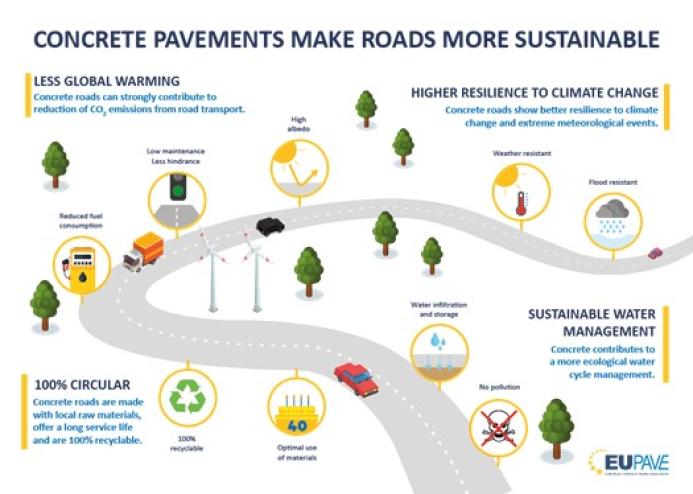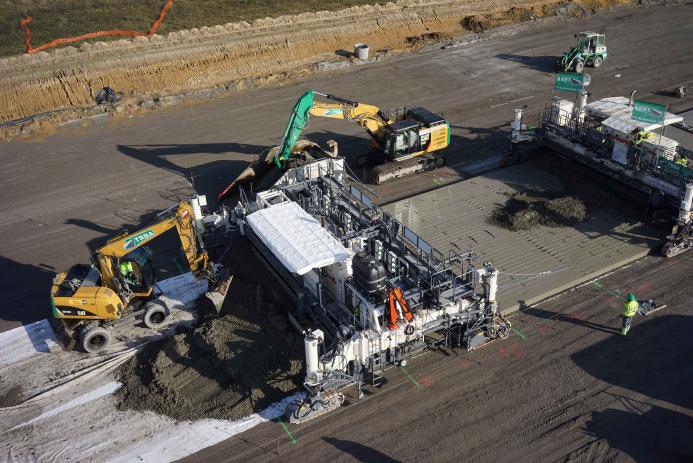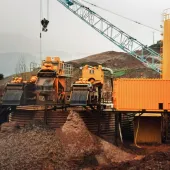Putting sustainability and resilience at the heart of concrete paving
This week's guest blogger is Luc Rens, C.E. Managing director, EUPAVE EUPAVE (the European Concrete Paving Association).
Today everyone is aware of the global challenges facing our society. The concept of “sustainable construction” has been at the heart of the construction world for many years, focusing on the three well-known pillars: economy, environment, and society. With the issue of global warming, the debate is now more focused on reducing CO2 emissions with a roadmap toward complete decarbonisation by 2050.
Sustainability: meeting the needs of the present without compromising the ability of future generations to meet their own needs (UN, 1987)
This certainly applies to the transport sector and therefore also to the road construction sector. Indeed, roads and road transport will continue to play an important role in moving people and goods in the future. For freight transport in particular, a further significant increase is expected in the coming decades and thus also a possible increase in environmental impact. Additional measures will therefore be necessary and decision-makers will have to make thoughtful and considered choices in the design, construction, and management of transport infrastructure.
The choice of the type of road pavement is one such choice, where the aim should be to find the most sustainable solution, taking into account all possible criteria, both in the short and long term. Even if the focus is mainly on measures to combat global warming, other important aspects need to be taken into account and are also high on the European Union's agenda. These include the circular economy, the resilience of our infrastructure, and sensible water management.
- Circular construction is about saving resources through prevention, reuse, and recycling. Resilient roads must be able to withstand increasing threats of natural and man-made disasters.
- Sustainability and resilience work in tandem, with resilience forming the foundation for all three pillars of sustainability.
- Ecological water management requires an integrated approach throughout the water chain to mitigate both problems of flooding and water shortage during periods of drought.
Resilience: the capacity of social, economic and environmental systems to cope with a hazardous event or trend or disturbance, responding or reorganising in ways that maintain their essential function, identity and structure, while also maintaining the capacity for adaptation, learning , and transformation (IPCC, 2014)
The European Concrete Paving Association, EUPAVE, is convinced that rigid solutions – concrete pavements and hydraulically bound base layers - can contribute to a more sustainable and resilient transportation network. Therefore, EUPAVE’s Sustainability & Resilience Working Group has prepared fact sheets covering the different themes.
The work started with an infographic “Concrete pavements make roads more sustainable”, showing the basic messages in the different domains. Next, the fact sheets were drafted in which each sub-aspect was discussed in more detail, each time based on the latest findings from international practice and research.

EUPAVE developed 6 fact sheets:
- Concrete roads can strongly contribute to a reduction of CO₂ emissions from road transport– HIGH ALBEDO.
- Concrete roads can strongly contribute to a reduction of CO₂ emissions from road transport– LESS FUEL CONSUMPTION.
- Concrete roads are made with local raw materials, offer a long service life, and are 100% recyclable – 100% RECYCLING.
- Concrete roads are made with local raw materials, offer a long service life, and are 100% recyclable – LONG SERVICE-LIFE – LOW LIFE-CYCLE IMPACT AND COST – LOW MAINTENANCE, LESS DISRUPTION.
- Concrete roads show better resilience to climate change and extreme meteorological events – HIGHER RESILIENCE.
- Concrete contributes to more ecological water-cycle management – SUSTAINABLE WATER MANAGEMENT.
These fact sheets are gathered in EUPAVE’s compilation of fact sheets.
In conclusion, concrete roads are a key part of creating a greener and resilient transportation system that deals with current challenges and future needs. EUPAVE's fact sheets are a useful guide, urging decision-makers to think about how their choices affect the economy, environment, and society in the long run.









Comments